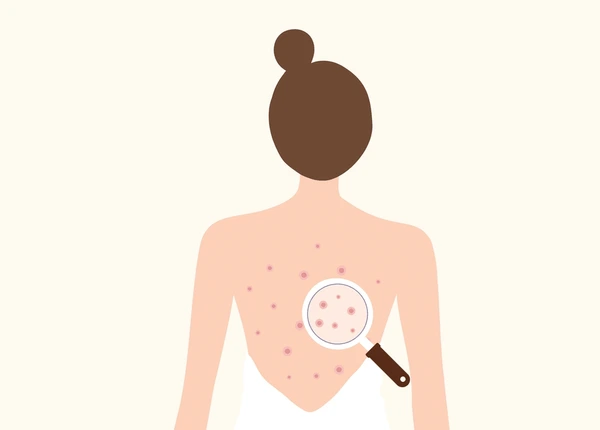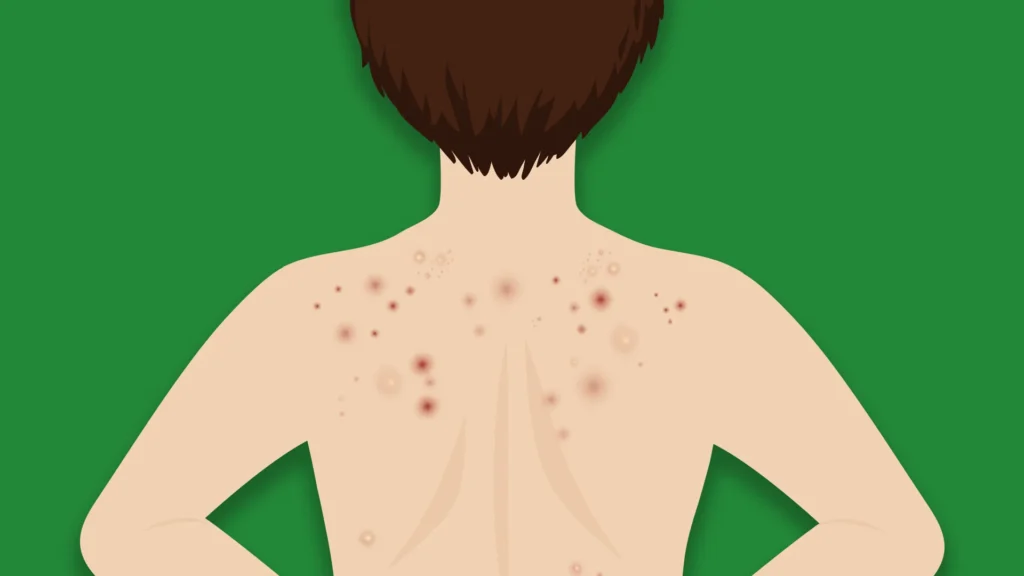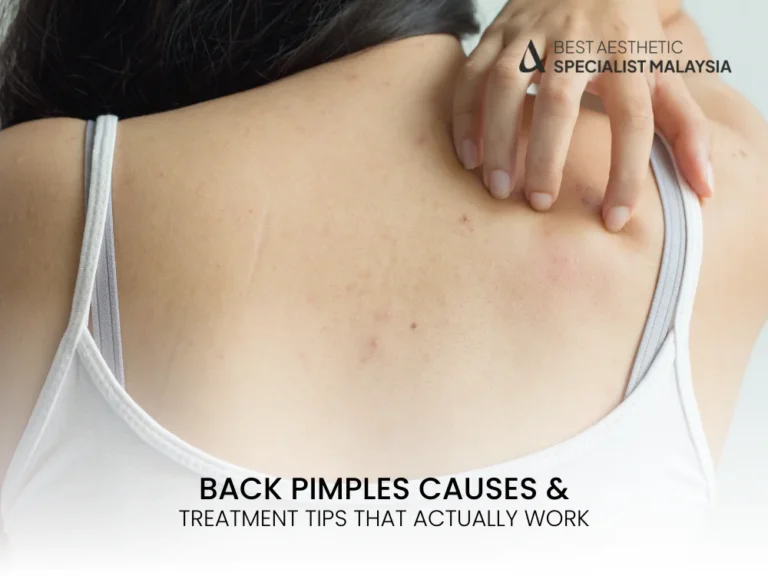Dealing with back pimples causes—often dubbed “bacne”—can be frustrating, uncomfortable, and even painful. Unlike facial acne, back breakouts are harder to see, treat, and keep under control. But here’s the good news: understanding the true back pimples causes can help you prevent and manage them effectively.
Let’s dive into the most common culprits behind those pesky back blemishes, how they develop, and what you can do to banish them for good.
What Are Back Pimples Causes?
Back pimples are essentially acne that occurs on the back, particularly the upper back and shoulders. These breakouts range from small blackheads and whiteheads to large cysts and inflamed nodules.
The skin on your back has larger pores and more sebaceous (oil) glands, making it prone to clogged pores, excess oil production, and irritation—especially when exposed to sweat, friction, and bacteria.

Hormonal Imbalance
Hormonal fluctuations—especially during puberty, menstruation, or conditions like PCOS—can increase sebum production. Excess sebum can clog pores, leading to inflammation and acne breakouts on the back.
Even adult men and women can experience hormone-related bacne, especially during times of stress, dietary changes, or when starting/stopping medications like birth control or testosterone boosters.
Sweat and Friction (Acne Mechanica)
Ever noticed breakouts after hitting the gym? Sweat mixed with tight clothing, backpacks, or sports gear can trap dirt and bacteria against your skin. This causes a form of acne called acne mechanica.
Wearing synthetic fabrics, not showering post-workout, or allowing sweat to dry on your skin for too long are all risk factors that promote back pimples causes.
Poor Hygiene Practices
It’s easy to miss your back when showering. Infrequent washing or failing to exfoliate properly allows dead skin cells, oil, and bacteria to accumulate.
Additionally, not changing your sheets or towels regularly can expose your skin to acne-triggering microbes and dirt.
Hair Products and Body Wash Residue
Thick conditioners, oils, and even certain body washes can clog pores if not rinsed thoroughly. Known as pore-clogging ingredients or comedogenic products, these can create a barrier that traps bacteria and oil.
Always rinse your body after washing your hair, and opt for non-comedogenic body care products.
Tight or Non-Breathable Clothing
Friction from tight clothing—especially if it traps sweat and bacteria—can irritate hair follicles and cause back breakouts. Sports bras, compression wear, and backpacks are common triggers.
Opting for breathable, moisture-wicking fabrics and washing your gym clothes after each use can make a big difference.
Diet and Food Sensitivities
Though diet isn’t the root cause of acne, certain foods can influence flare-ups. High glycemic index foods (like sugar, white bread, and dairy) may contribute to excess sebum production and inflammation.
If you’re consistently breaking out on your back, keeping a food journal might help identify potential triggers.
Genetics
Just like facial acne, your genes can play a big role. If one or both of your parents had acne-prone skin, you’re more likely to develop it, including on the back.
This doesn’t mean you’re powerless, but it does mean your skin may require consistent care and targeted treatment.
Stress and Cortisol Levels
Chronic stress triggers the release of cortisol, a hormone that ramps up oil production and can worsen acne. Combined with a weakened immune system, stress makes it harder for your body to heal existing pimples.
Stress-reducing techniques like yoga, deep breathing, and adequate sleep can help reduce back breakouts.

Bodybuilding Supplements and Steroids
Supplements like whey protein, creatine, and anabolic steroids can increase testosterone levels and oil production. Many bodybuilders experience back acne as a result of these supplements.
If you notice acne after introducing a supplement, consider talking to your doctor or switching to a cleaner alternative.
How to Treat Back Pimples Causes Effectively
Now that we’ve covered what causes them, here are proven strategies to help clear and prevent bacne:
- Use medicated body washes with salicylic acid or benzoyl peroxide.
- Exfoliate 2–3 times weekly with a gentle scrub or chemical exfoliant.
- Shower immediately after sweating, especially post-workout.
- Switch to breathable clothing and avoid tight straps that rub.
- Try topical retinoids or consult a dermatologist for prescription options.
- Keep hair off your back and rinse thoroughly after shampooing.
Back Pimples Causes: When to See a Dermatologist
Back acne can be frustrating, but in many cases, simple lifestyle changes, over-the-counter washes, and consistent skincare are enough to manage it. However, there are situations where seeking professional help from a dermatologist is the best option. If your breakouts are painful, cystic, or frequently leave behind dark spots and scars, it’s a clear sign that your skin needs medical attention.
One of the main reasons to see a dermatologist is persistent or severe acne that does not respond to common treatments. Cystic back acne, for instance, often forms deep under the skin, causing inflammation and tenderness that cannot be treated effectively with topical products alone. In such cases, a dermatologist can prescribe oral antibiotics to reduce inflammation and bacterial growth, or hormonal therapy like spironolactone for women whose acne is linked to hormonal fluctuations.
For individuals dealing with stubborn marks and pigmentation, dermatologists may recommend professional treatments such as chemical peels, microdermabrasion, or laser therapy. These procedures not only help clear active breakouts but also improve skin texture and fade acne scars over time. In the most severe and resistant cases, a course of isotretinoin (Accutane) may be considered. While this treatment requires close monitoring due to potential side effects, it remains one of the most effective long-term solutions for chronic back acne.
Another important reason to seek dermatological advice is when back acne affects your quality of life. If you find yourself avoiding certain clothes, skipping social activities, or feeling self-conscious about your skin, a dermatologist can provide both medical treatment and emotional reassurance. Acne is not just a cosmetic issue—it can impact confidence and mental well-being, making professional support invaluable.
Ultimately, scheduling an appointment with a dermatologist ensures that your skin receives the right care tailored to your condition. Rather than continuing with trial-and-error treatments, a professional evaluation provides clarity, stronger prescription options, and advanced therapies that can restore clearer, healthier skin. If your back acne isn’t improving after a few months of consistent self-care, don’t wait—expert help is the next best step.
Natural Remedies That May Help Back Pimples Causes
Some people find relief using natural treatments such as:
- Tea tree oil (antibacterial)
- Aloe vera gel (soothing)
- Apple cider vinegar toner (pH balancing)
- Oatmeal masks (anti-inflammatory)
Use natural remedies with caution and always patch test first.
FAQs
1. Why do I get back pimples causes but not my face?
The skin on your back has larger pores and more oil glands, making it more susceptible to trapped sweat, friction, and bacteria than your face.
2. Can certain fabrics cause back acne?
Yes. Tight, non-breathable fabrics can trap heat and moisture, increasing the risk of irritation and clogged pores, especially during workouts.
3. Is back acne a sign of a health issue?
While it’s usually not serious, persistent or cystic bacne may be linked to hormonal imbalances or certain medications and should be evaluated by a dermatologist.
4. Do back pimples causes leave scars?
Yes, if picked or untreated, back pimples—especially deep ones—can leave dark marks or pitted scars. Early treatment helps prevent scarring.
5. How long does it take to clear back acne causes?
With consistent care, mild to moderate back acne may improve within 4–6 weeks. Severe cases may take longer and require medical intervention.
6. Can diet affect back acne?
Yes. Diets high in dairy, refined sugar, and processed foods may worsen back acne by increasing inflammation and oil production. Eating a balanced diet rich in whole foods can support clearer skin.
7. Does sweating make back acne worse?
Sweating itself isn’t the cause, but if sweat mixes with oil, dirt, and bacteria, it can clog pores. Showering soon after workouts or intense activity can help reduce breakouts.
8. What skincare products should I avoid for back acne?
Avoid heavy, oily, or comedogenic lotions and sunscreens that can clog pores. Instead, choose lightweight, oil-free, and non-comedogenic products.
9. Is back pimples causes genetic?
Yes, genetics play a role. If acne runs in your family, you may be more prone to developing it on your back as well as your face.
10. Can stress cause back acne?
Stress doesn’t directly cause back acne, but it can trigger hormonal fluctuations that increase oil production, leading to more frequent breakouts.
11. Should I exfoliate if I have back acne?
Gentle exfoliation can help remove dead skin cells and prevent clogged pores. However, avoid harsh scrubs that can irritate the skin and worsen inflammation.
12. Can swimming help back acne?
Chlorinated water may temporarily dry out acne, but frequent swimming without rinsing off can irritate the skin. Always shower after swimming to prevent flare-ups.
13. What is the best sleeping position for preventing back acne?
Sleeping on clean sheets and avoiding positions where sweat and friction build up (like lying flat on your back without breathable bedding) can help reduce breakouts.
14. Do hormones cause back acne in adults?
Yes, hormonal changes—especially in women due to menstrual cycles, pregnancy, or PCOS—can trigger excess oil production, leading to back acne.
15. Can professional treatments help back pimples causes?
Yes, dermatologists may recommend treatments like chemical peels, laser therapy, or prescription medications to target stubborn or severe back acne.
Final Thoughts on Back Pimples Causes
Back pimples causes can be persistent, but they’re far from untreatable. From hormonal shifts to sweat and product buildup, many factors contribute to their development. With the right skincare habits, product choices, and a proactive mindset, you can significantly reduce breakouts and regain smooth, clear skin.
Remember, your back deserves just as much attention and care as your face. Treat it well—and it will thank you.

